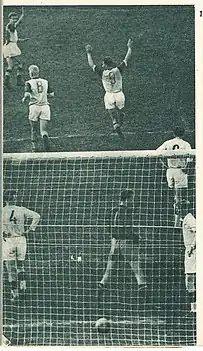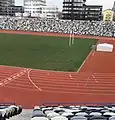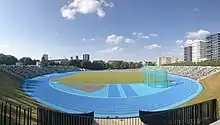Kalevi Keskstaadion
Kalevi Keskstaadion is a multi-purpose stadium in Tallinn, Estonia. Opened in 1955 and having a capacity of 12,000, it is the traditional venue of the Estonian Dance Festivals and the home ground of JK Tallinna Kalev. The address of the stadium is Staadioni 8, 10132 Tallinn.
.jpg.webp) | |
| Former names | Komsomoli Staadion |
|---|---|
| Location | Tallinn, Estonia |
| Owner | Sports Association Kalev |
| Capacity | 12,000 |
| Surface | Grass |
| Construction | |
| Opened | 1955 |
| Renovated | 2022 |
| Architect | Erika Nõva Peeter Tarvas |
| Tenants | |
| Kalev Tallinn (until 2019) Tallinna Sadam (until 1998) | |
Since 1955, all of the Estonian Dance Festivals have been held there.[1]
History
The stadium was built during the Soviet occupation of Estonia and was opened on 12 July 1955. It was the first new large-scale sports complex built in Tallinn after World War II. The initial plans were grandiose: the first blueprints saw the stadium have a 30,000 capacity seating area and a 16,000 capacity standing area, as well as a 6 meter tall statue depicting Estonian folklore hero Kalevipoeg.[2] However, the project was later scaled-down and saw the stadium have a capacity of 12,000.

In 1960, Tallinna Kalev joined the Soviet Top League and in the following two years, the stadium hosted numerous high profile football matches. The match against Dynamo Moscow brought more than 20,000 people onto the stands and among the players playing was Dynamo's Lev Yashin, who won the Ballon d'Or three years after said match and is regarded by many as the greatest goalkeeper in the history of the sport.
In 1963, the stadium hosted its first Estonian Dance Festival and has remained as the traditional venue of the celebration since.
The 2000s saw the stadium's condition worsen to the point that in 2007, the Estonian FA declared the grass pitch unusable for top-flight football.[3] In 2015, it was announced that Kalevi Keskstaadion will undergo a major renovation and the concept design also included a possibility to increase the capacity to 30,000 in the distant future.[4] The renovation works began after the 2019 Estonian Dance Festival and the stadium was re-opened in 2022.[5]
Artificial turf stadium
The sports complex of the Kalevi Keskstaadion also has an artificial turf ground named Kalevi kunstmurustaadion. Located at the southwest corner of the main stadium, the field is home to Kalev's youth system.
Gallery
.jpg.webp) Kalevi Keskstaadion is also a venue for Estonian Dance Celebration.
Kalevi Keskstaadion is also a venue for Estonian Dance Celebration. Stadium at its full capacity.
Stadium at its full capacity. The stadium (in the bottom left corner) in February 2009
The stadium (in the bottom left corner) in February 2009 The stadium in 2019
The stadium in 2019 Kalevi Keskstaadion after renovation works in August 2022
Kalevi Keskstaadion after renovation works in August 2022
References
- Kalevi Keskstaadion – Eesti Rahvusstaadioniks. Staadioni tn 3 arendus- ja planeeringu kontseptsioon.
- "Kalevi staadion". Longread. 2017-06-22. Retrieved 2022-12-16.
- Soccernet.ee (2007-07-11). "Kalevi Keskstaadion tunnistati mängukõlbmatuks". Soccernet.ee - Jalgpall luubi all!. Retrieved 2022-12-16.
- "Kalevi keskstaadioni arhitektuurikonkursi võitis ideekavand "Katel"". Moodne Kodu (in Estonian). Retrieved 2023-02-13.
- ERR, Katre Roomets | (2022-06-28). "Uuenduskuuri läbinud Kalevi keskstaadion ootab kasutusluba". ERR (in Estonian). Retrieved 2022-12-16.